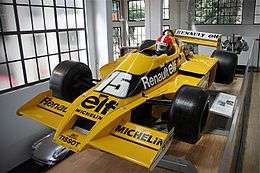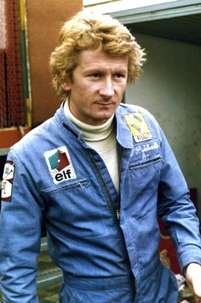Jean-Pierre Jabouille
Jean-Pierre Alain Jabouille[1] (born 1 October 1942) is a French former racing driver. He raced in 55 Formula One Grands Prix, collecting two wins during the first years of Renault's turbocharged programme in the late 1970s and early 1980s. Jabouille also raced the 24 Hours of Le Mans from the late 1960s to the early 1990s, driving for Alpine, Matra, Sauber and Peugeot and collecting four 3rd overall finishes in 1973, 1974, 1992 and 1993. Jabouille was one of the last of a breed of Formula One drivers who were also engineers.
 Jabouille in 2012 | |
| Born | 1 October 1942 Paris, France |
|---|---|
| Formula One World Championship career | |
| Nationality | |
| Active years | 1974–1975, 1977–1981 |
| Teams | Frank Williams Racing Cars, Surtees, Tyrrell, Renault, Ligier |
| Entries | 55 (49 starts) |
| Championships | 0 |
| Wins | 2 |
| Podiums | 2 |
| Career points | 21 |
| Pole positions | 6 |
| Fastest laps | 0 |
| First entry | 1974 French Grand Prix |
| First win | 1979 French Grand Prix |
| Last win | 1980 Austrian Grand Prix |
| Last entry | 1981 Spanish Grand Prix |
Career


Jabouille first made his mark in French Formula Three in 1967, and continued in 1968, maintaining the car himself on his way to the runner's up spot behind François Cevert. For 1969 he was contracted as a development driver by Alpine, having several disjointed runs in Formula Two and sports cars. In 1973 he co-drove a Matra to 3rd at the Le Mans 24 Hours, and repeated this feat in 1974, when he also won the Formula Two race at Hockenheim, and finished as runner-up in the European 2-litre series for Alpine. He also made his first appearances in Formula One, failing to qualify an Iso–Marlboro at the French Grand Prix, and a Surtees at the Austrian Grand Prix.
1975 saw Jabouille sever his ties with Alpine, and gain Elf backing to make his own Formula Two chassis. He finished runner-up to Jacques Laffite, but finally made his full Grand Prix debut, finishing 12th in a works Tyrrell at the French Grand Prix. For 1976 he concentrated on Formula Two, finally winning the title.
Formula One with Renault
Jabouille was signed up by Formula One team Renault to develop their new 1.5l turbocharged engine for 1977. The RS01 car debuted at the 1977 British Grand Prix, but initially the turbo engine (a first for Formula One) was fragile and suffered from severe turbo lag, making it difficult to drive on tight circuits. However, Jabouille persevered, recording several notable qualifying positions in 1978, and landed the marque's first points with 4th place at the United States Grand Prix East.
1979 saw Renault expand to run a second car for René Arnoux. Jabouille secured Renault's first Formula One pole at the South African Grand Prix, and then won their first victory, fittingly at the French Grand Prix, also from pole. This was the first victory for a turbocharged car in Formula One. He took two more poles, at the German and Italian Grands Prix, but poor reliability meant the win was his only score.
In 1980 Jabouille took two more poles, and another win at the Austrian Grand Prix. However, a suspension failure in the Canadian Grand Prix left him with a broken leg, just after he had signed with Ligier for 1981.
His injuries saw him sit out the first two races of the 1981 season, but it soon became clear he wasn't fully fit, failing to qualify for two of his four attempts, at which point he decided to retire from Formula One, and he then became manager of the Ligier/Talbot team in 1982.
Sportscars
Jabouille returned to racing in the mid-1980s, driving in the French Supertouring Championship before joining Peugeot to help develop their sports car programme at the 24 Hours of Le Mans. This culminated in third place places for the marque in both the 1992 and 1993 races. In 1994 he succeeded Jean Todt as director of Peugeot Sport, but unsuccessful seasons for Peugeot as engine suppliers in Formula One with McLaren and Jordan saw him sacked in 1995. Since then he has run his own sports car team in the ISRS.
Racing record
Complete European Formula Two Championship results
(key) (Races in bold indicate pole position; races in italics indicate fastest lap)
| Year | Entrant | Chassis | Engine | 1 | 2 | 3 | 4 | 5 | 6 | 7 | 8 | 9 | 10 | 11 | 12 | 13 | 14 | 15 | 16 | 17 | Pos. | Pts |
|---|---|---|---|---|---|---|---|---|---|---|---|---|---|---|---|---|---|---|---|---|---|---|
| 1968 | Matra Sports | Matra MS7 | Cosworth FVA | HOC | THR | JAR | PAL | TUL | ZAN | PER | HOC 9 |
VAL | NC | 0 | ||||||||
| 1970 | Constructions Mécaniques Pygmée | Pygmée MDB15 | Cosworth FVA | THR DNQ |
HOC | BAR 11 |
ROU DNQ |
PER 8 |
TUL | IMO DNQ |
HOC DNS |
16th | 2 | |||||||||
| 1971 | Equipe Tecno Elf | Tecno TF71 | Ford BDA | HOC Ret |
THR | NÜR | JAR DNQ |
PAL DNQ |
ROU DNQ |
MAN | TUL | ALB DNQ |
VAL | VAL | NC | 0 | ||||||
| 1972 | Elf John Coombs | March 722 | Ford BDA | MAL Ret |
THR | HOC | IMO NC |
MAN 2 |
PER Ret |
14th | 7 | |||||||||||
| Alpine A367 | PAU DNQ |
PAL | HOC | ROU DNS |
ÖST Ret |
SAL 9 |
ALB Ret |
HOC 10 |
||||||||||||||
| 1973 | Elf John Coombs | Alpine A367 | Ford BDA | MAL | HOC | THR Ret |
NÜR Ret |
PAU | KIN | NIV | HOC | ROU DNS |
MNZ | MAN Ret |
KAR | PER Ret |
SAL | NOR | ALB 5 |
VAL | 24th | 3 |
| 1974 | Ecurie Elf | Alpine A367 | BMW | BAR 3 |
HOC | PAU 4 |
SAL Ret |
HOC 1 |
MUG 7 |
KAR | PER | HOC 3 |
VAL Ret |
4th | 20 | |||||||
| 1975 | Ecurie Elf | Elf 2J | BMW | EST 8 |
THR 5 |
HOC Ret |
NÜR 4 |
PAU 2 |
HOC Ret |
SAL 1 |
ROU Ret |
MUG Ret |
PER Ret |
SIL Ret |
ZOL Ret |
NOG 3 |
VAL | 5th | 24 | |||
| 1976 | Ecurie Elf | Elf 2J | Renault | HOC Ret |
THR 14 |
VAL 1 |
SAL 6 |
PAU 3 |
HOC 4 |
ROU 2 |
MUG 1 |
PER 4 |
EST 2 |
NOG Ret |
HOC 1 |
1st | 53 |
24 Hours of Le Mans results
Complete Formula One results
(key) (Races in bold indicate pole position)
References
- FIA Year Book of Automobile Sport 1976. Patrick Stephens Ltd. white p. 38. ISBN 0-85059-229-1.
- "Jean-Pierre Jabouille, France". racingsportscars.com. Retrieved September 13, 2017.
| Sporting positions | ||
|---|---|---|
| Preceded by Jacques Laffite |
European Formula Two Champion 1976 |
Succeeded by René Arnoux |